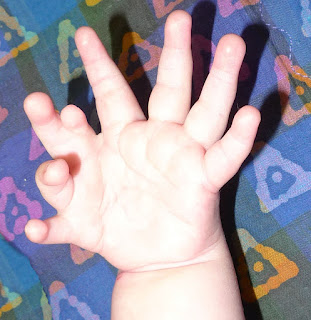I have been remiss in that I have not given an overview of limb formation. Mind you, this is a topic that is constantly changing- we learn more each year about the process, the proteins, the timing, etc. So this is a hand surgeon’s perspective in 2012. There are others with a much better understanding of limb development– people who continue to add to our understanding. I have enjoyed getting to know Kerby Oberg from Loma Linda, one of those people. He is a vital part of a congenital hand surgery study group as well. http://www.llu.edu/medicine/basic-sciences/faculty/anatomy/oberg-kerby.page
The upper limb forms from about 28 days of gestation to about 56 days of gestation- that’s right from 4 to 8 weeks of gestation. Many women may not even be aware of pregnancy at that time. By the 8 week point, the arm and hand are in an amazingly, fully formed state. There are fingers, a thumb, and joint with a big- picture normal appearance.
So, how do we get there?
The limbs start to form based on signaling mechanisms, genes, and proteins (and everything is about genes, signaling and proteins). TBX-5 and TBX- 4 are genes that help “turn- on” upper and lower limb formation respectively. The upper limb is about 2 days ahead of the lower limb. HOX genes play a role as well. There are three axes that guide limb development: proximal/ distal, anterior/ posterior, and dorsal/ ventral.
If you imagine that the developing limb is a blob of cells, the center of the blob is mesodermal cells and the outer layer is ectodermal cells. The complex interaction between these cells guides development of the arm. The outer layer is called apical ectodermal ridge (AER for short) and it continually interacts with the inner cells of the mesoderm. Fibroblast growth factors (FGFs) are the key to this interaction. But importantly, the AER guides limb growth or lengthening. If you take away the AER, the limb stops growing.
The other key area is on the back side (post axial) of the limb and is termed the zone of polarizing activity (ZPA). The ZPA interacts with the AER and the developing limb to help determine the development of the different parts- specifically thumb side of limb (radial side) versus pinky side of limb (ulnar side). This is based on a morphogen called sonic hedgehog (which can be abbreviated Shh). (lab humor= the name ‘sonic hedgehog’). This protein affects development of the fingers, thumb, etc. Some really amazing experiments showed that if you take the ZPA (or even the sonic hedgehog) and add it to the other side of the developing limb, you can develop a “mirror” limb as more fingers develop. This is described beautifully in one of my favorite articles: http://genepath.med.harvard.edu/~tabin/Pdfs/Riddle.pdf
 |
| This is a mirror hand with 8 fingers. We believe this happens due to problems or duplication of the ZPA. |
And the ZPA interacts with the AER constantly as the limb develops. Check out the simple drawing (from 12 years ago!) which emphasizes this interaction:
 |
| Complex interaction between ZPA and AER, simplified. |
http://www.nature.com/nature/journal/v408/n6810/fig_tab/408313a0_F5.html
Finally, Wnt 7a and Lmx-1 help determine the top and bottom of the limb and fingers (ie nail side of finger vs palm side).
I will refer back to this blog on limb development as it relates to anomalies.
Thank you very much.
I’m curious if it’s a “blood flow issue” that causes symbrachdactyl, what is the issue? If i would have been ok blood thinners or even an asprin when pregnant, would my baby’s hand have developed? She was born with what i think you would categorize as “sever” with a small wrist and nubbins, no formed digits on her right hand and a typical left.
Thank you for the question. And congratulations on the birth of your daughter. First, this is a better conversation in person with your doctor but certainly, please don't blame yourself or seek to understand what you could have done differently- almost certainly nothing. There are risks to taking aspirin and blood thinners. We believe, but do not know for certain, that blood flow is the 'cause' of symbrachydactyly but yet, many cases have multiple causes and certainly there are factors we do not understand. I hope this helps.
What could cause blood flow issues please ?
There are likely a number of reasons for decreased blood flow from uncertain, to blood clotting, to a mechanical constriction to blood flow. For almost all kids, the reason is unclear.